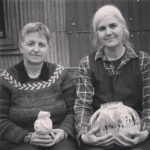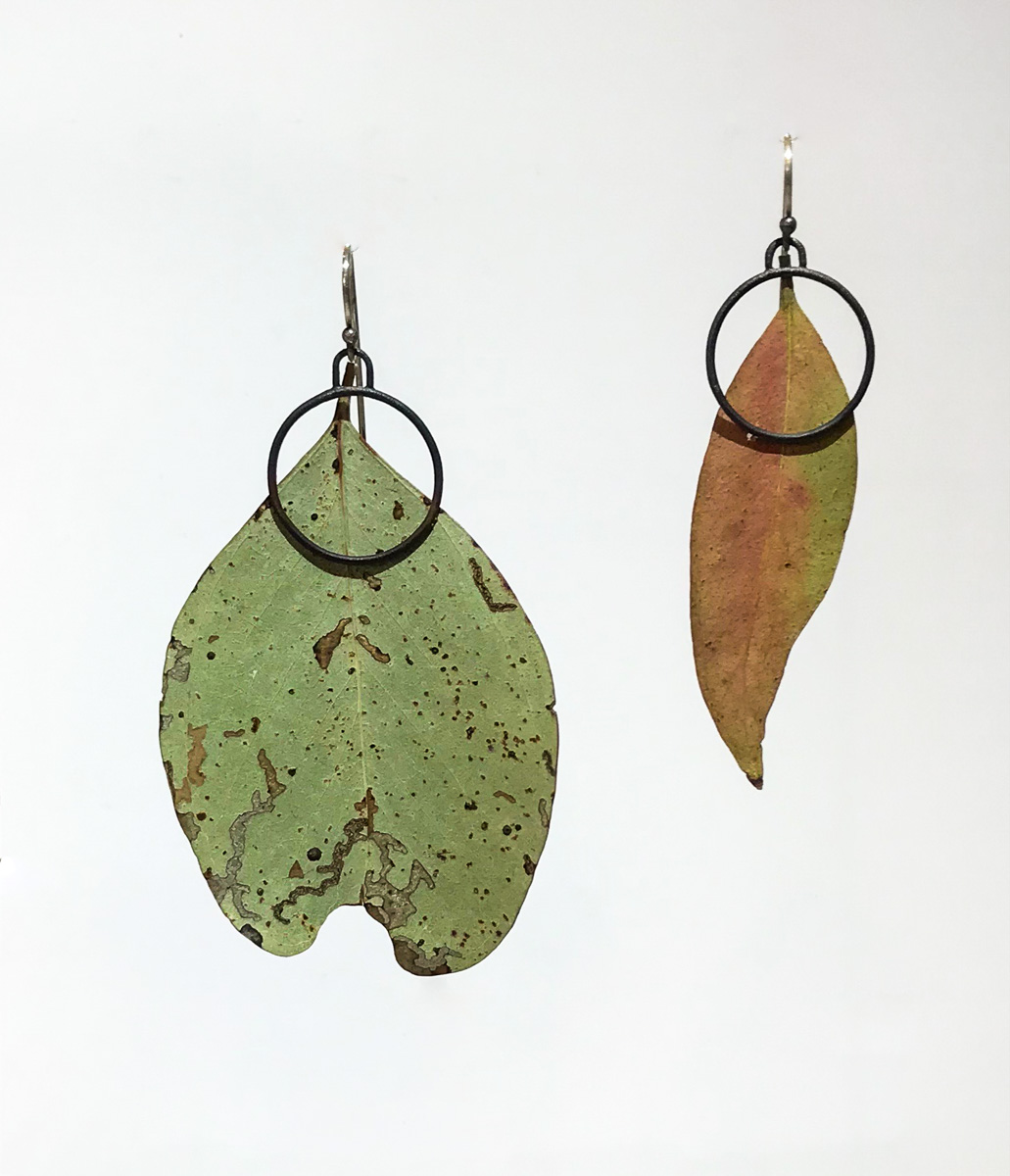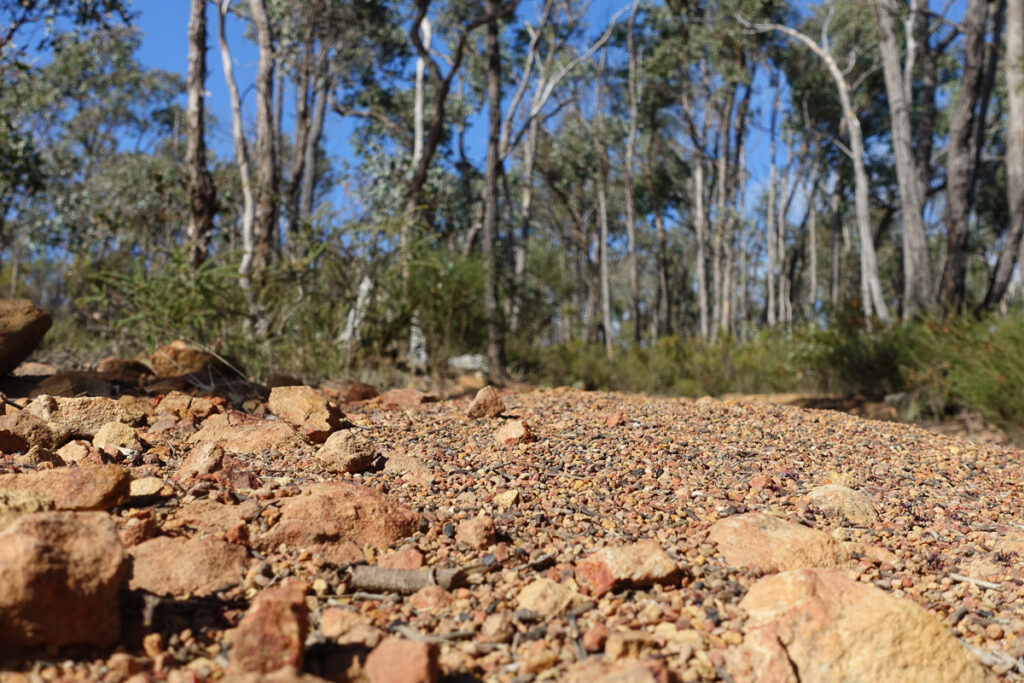- fluxed earth, Dolomite forage vase
- fluxed earth, Iron red forage vase
- fluxed earth, Orange shino forage vase
- fluxed earth, Green celadon forage vase
- fluxed earth, White shino forage vase
Kirstie Murdoch & Rye Senjen share their daily bush walk and the vases that provide a place for what we ourselves might gather.
The path is stony, rutted and at times steep. The forest appears sparse, but on closer inspection there is an astonishing diversity of plants and animals surrounding us. We encounter what may be considered the insignificant and easily overlooked: the flash of an orange-red anther inside a grass flower; a tunnel constructed by ants with a cone of clay and gravel at its entrance; a tiny orchid flower held just above the rocky ground; a cluster of sundews covered in sticky droplets; spiky seed pods and new red growth on the local hakea.
This is how our day begins. Every morning the three of us walk in the box-ironbark forest that extends behind our house: Kirstie, Rye and Hazel Bean the dog. The experience changes with the seasons: mostly the sky is a very clear blue, sometimes the air is sharp with frost, other mornings the coolness is refreshing before the hot day ahead.
We listen for the bird calls that change with the seasons. The noisy groups of choughs, ravens and various parrots are present year-round. The rufous whistlers sing loudest in the spring. Thornbills and pardalotes fly about the upper branches of the eucalypts. We occasionally hear the quick thump of a swamp wallaby – and more frequently the slower rhythm of grey kangaroos.
- Morning walk in the box ironbark forest
- Stones on the path
Too often we hear comments that this landscape is badly degraded, the soil is “poor”, the bush “scrappy”. While it is true that the post-gold rush landscape here in central Victoria differs markedly to what went before, and there has clearly been much loss, there is still so much life here. The regenerated box-ironbark forest is home to an incredible diversity of plants, rocks, fungi, reptiles, mammals, birds, insects and spiders.
This land and these daily walks inform our work. The small stones we collect reappear as inclusions in our vases, the colours of the land are reflected in our glazes. The landscape manifests itself in our forms. The daily walks have also encouraged us to take in the small and seemingly insignificant things: to listen and observe.
Part of our day is also spent caring for our garden, which is being created to reflect the layering and complexity we observe in the local bush landscape. As we care for our garden, we are including many plants that also grow in our local box-ironbark forest and local grasslands. We also are including plants from other parts of Australia and around the world that can survive the summer dry of our climate, develop the soil and provide habitat and food for insects, reptiles, birds and other locals. Some of these plants have striking flowers, some have interesting foliage textures and colours – all call for closer inspection. We are aiming for an adaptive garden, responding to the changing and increasingly unpredictable climate.
Being mindful of these two influences in our lives, we started to make what we call garden forage vases. These vessels exist to hold and frame a few flowers, a small branch with interesting leaves or some soft grasses from the garden. The forage vases are shallow, bowl-shaped vessels and include a flower holder insert that is specifically made for each vase. Flowers, stems and branches are supported in the holes of the holder, which sits in the water-filled bowl of the vase like an island in a pond. The vases are intended to celebrate the beauty of the commonplace. They do not require classically showy flowers or special flower arranging skills. A few grass seed heads, a leafy branch or some small flowers is all that is required.
Our forage vases are formed out of a plain white stoneware clay body to which we add some earthy terracotta clay and sometimes small stones. The vases are hand-built from slabs and coils, and are shaped and carved at various stages during the drying of the clay.
The vases are glazed and fired between 1280 and 1300 ºC in a reducing atmosphere, which enables the glazes to melt into muted and soft colours. We make all glazes from scratch using simple raw materials, including eucalyptus wood ash, feldspar, iron oxides and clay. The intention is for the vase to support rather than overwhelm the botanicals and the glazes are chosen accordingly.
The vases are built in stages. As each coil is added, smoothed and shaped, the vase slowly emerges. Once the basic shape is completed, carving refines the form and textures the surface. The repeated handling of the vase results in an irregular, organic form that sits quietly in the hands or on the table.
The forage vases are subtle and quiet and they are clearly incomplete when empty. The flat space and holder within is calling out for collected botanicals. Hence the forage vases encourage us to explore and acknowledge the botanical variety of our gardens.
About fluxed earth
 fluxed earth is the collaboration of Rye Senjen and Kirstie Murdoch: ceramicists based in Castlemaine, Victoria, Australia. We work together to produce hand-built and wheel-thrown vessels and objects from mixes of Australian stoneware and terracotta clays. Our focus is on traditional Chinese and Japanese high-fire glazes. Our work is influenced by the textures, colours and sounds of the box-ironbark forest surrounding our studio. The land on which we live and make our ceramics is unceded Dja Dja Wurrung Country. Follow @fluxedearth or visit fluxedearth.com.
fluxed earth is the collaboration of Rye Senjen and Kirstie Murdoch: ceramicists based in Castlemaine, Victoria, Australia. We work together to produce hand-built and wheel-thrown vessels and objects from mixes of Australian stoneware and terracotta clays. Our focus is on traditional Chinese and Japanese high-fire glazes. Our work is influenced by the textures, colours and sounds of the box-ironbark forest surrounding our studio. The land on which we live and make our ceramics is unceded Dja Dja Wurrung Country. Follow @fluxedearth or visit fluxedearth.com.
The photo of Rye Senjen and Kirstie Murdoch is by Libby Angel.
✿
While we are foraging…










Comments
A lovely walk in the box forest. Thanks
We have one of these vases. They provide a simple way to create amazing displays.
Very enjoyable reading experience. Thanks also for the Australian bush photos as I have not been able to go there recently with the extended lockdowns. So miss that.